Samples often get categorized as scientists are tracking them. By defining and using
Sample Status values, your users can easily tell whether samples are available, consumed, or locked (unavailable). Aliquots have status values separate from their parent sample.
Sample Manager supplies basic built in status values,
Available, Consumed, and Locked, and an administrator can add additional statuses in any of these categories to match their workflows. For example, custom status values could be used to track which samples have been shipped, received, are in use, are offsite, etc.
Manage Sample Statuses
The Sample Manager application has 3 built-in statuses, also representing three main types of status:
- Available: Can be used.
- Consumed: Used up, and no longer can be aliquoted or checked out, but remains in the system for analysis and tracking.
- Locked: Not currently available, but may later become available.
From the main menu, click
Sample Types then select
Manage > Sample Statuses.

Scroll down to find the current set of defined statuses. A lock icon indicates that there are currently samples "using" that status value so that it may not be deleted and its type cannot be changed. Additional status values can be defined that mean the same things. For example, "Received" might be an interim internal status on they way to full availability. The sample is neither consumed, nor locked, but might still need a step like assignment to a storage location before it will be switched to full "Available" status.
Samples in certain statuses will be prevented from certain actions, both in the UI and enforced by the server. For example, a Locked sample can't be deleted or checked out of storage, a consumed sample can't be aliquoted, etc. An administrator may, however, update the status of a sample if a mistake was made or conditions have changed.
View or Edit Status Details
Click the name of a status to see details on the right. Here you may edit the Label, Description, and for statuses not currently in use, you can change the Status Type.
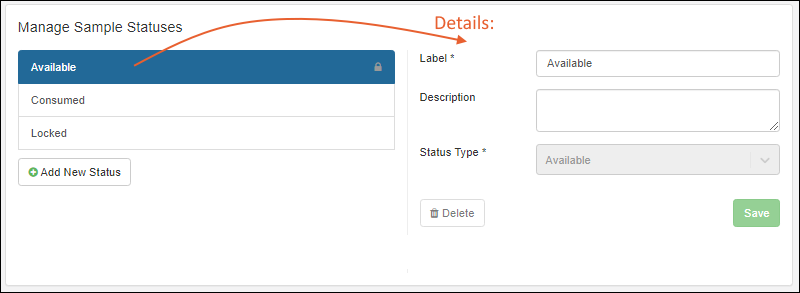
Add New Status
The three main statuses correspond to the three main "status types" with different actions allowed for each type. Adding additional custom status settings can support your lab's procedures and user expectations. Click
Add New Status and populate the fields on the right.
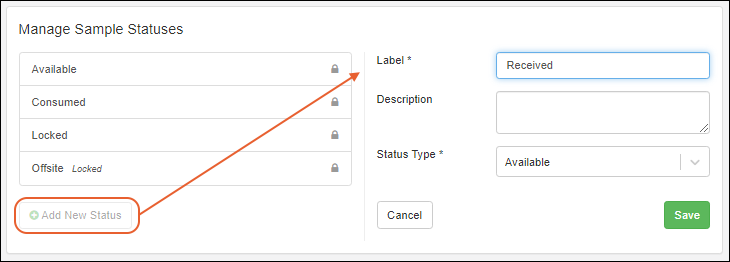
For example, you might add a new status named "Received" which is another form of the "Available" type of status, representing newly arrived samples which may need an additional step performed before they are officially "Available" to your users.
Assign Sample Status
Users can assign statuses to their samples throughout the system:
- At sample creation
- During file import of new or updated samples
- When updating a single sample's details
- In a bulk sample update
Aliquots have status values separate from their parent sample.

The status of a sample can later be changed by editing in a grid or in bulk for a set of samples at once.
Change Status to Consumed
When you change the status of a sample to "Consumed" (i.e. to any named status of the "Consumed" type), this typically means that there is no more of the sample to be used. If the sample is in storage, the user will also be prompted to set the storage status to "Discarded".
When editing a single sample's details, use the checkbox to also
Discard sample, optionally adding a comment:

When editing in bulk, saving will open a popup where you can check
Yes, discard the sample(s) and optionally enter a comment:
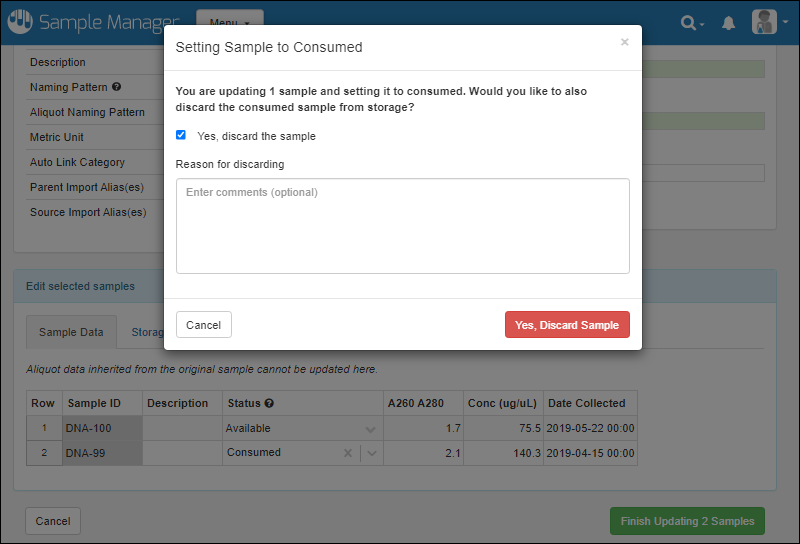
Sample Status Legend
To see the set of available status values, hover over the
for the
Status column or field to see a legend listing all the available status values and their color coding.
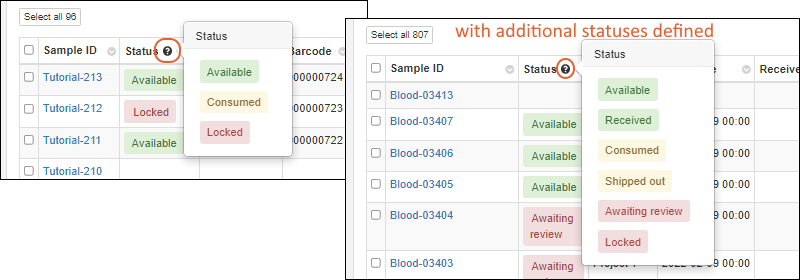
View a Sample's Status
Sample status information will be displayed in sample grids and on the sample overview and storage sample details pages. Color-coded blocks and the
legend make it easy to see status at a glance. The name of the specific status will be shown, with the color applied based on the type of status it is:
- Available: green
- Consumed: yellow
- Locked: red
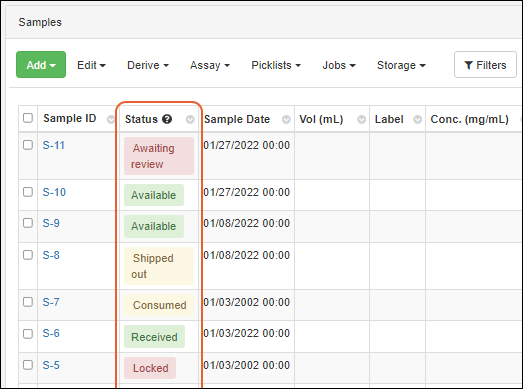
Sample Status and Storage Status
Sample Status can be viewed for a sample in storage, and is not the same as the
Storage Status (In Storage, Checked Out, etc), described further in this section:
Storage ManagementSample status values are available in storage views as part of the sample details. Hovering will show the description of the status value, as shown below for a locked sample.
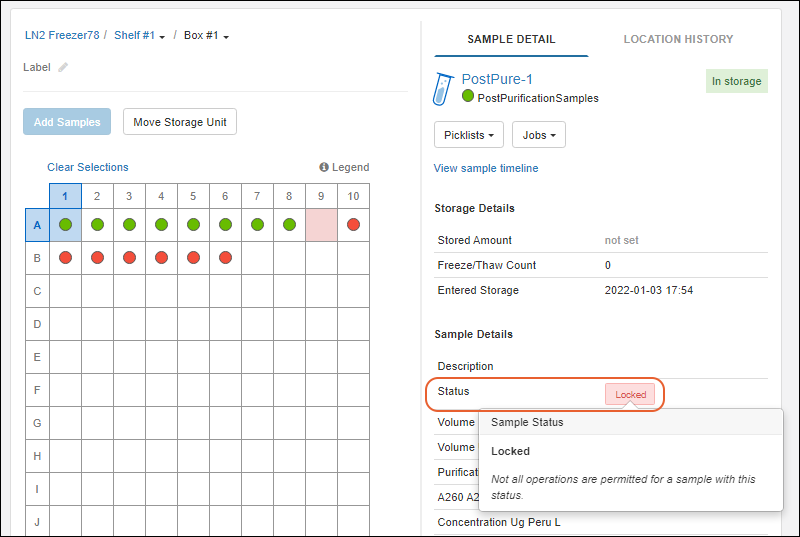
Sample Count by Status Dashboard
On the main dashboard, you can see an overall picture of the status of your samples using the
Sample Count by Status chart. A bar for each Sample Type is color coded to show how many samples of that type in each status. Sample statuses of the same main type (such as "Available" and "Received" in this image) will share the same color (in this case, green).
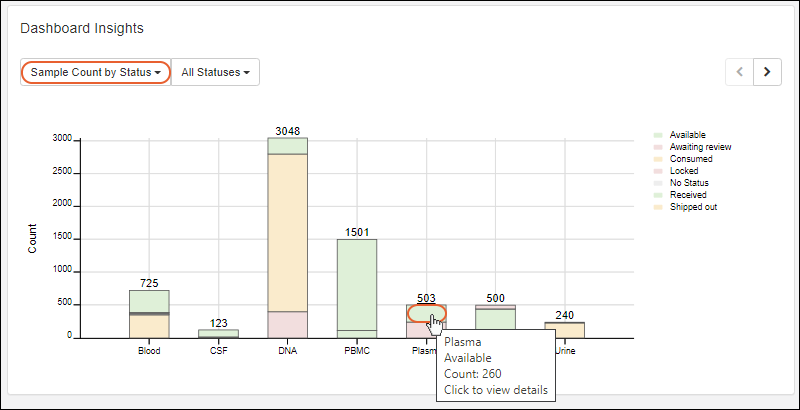
Hover over any bar segment for more details and click for the filtered set of samples of that type in that status; shown above, you'd see 260 "Available" Plasma samples.
Use the refinement menu, select
All Statuses, With a Status, or No Status to control which sample statuses are displayed. For instance, using the
No Status option, you can easily see and click through to the subset of samples that still need to have a status assigned, in this case in two sample types.
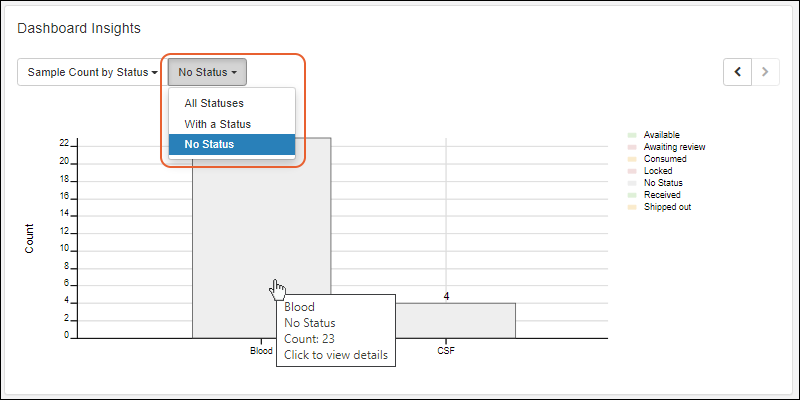
Related Topics